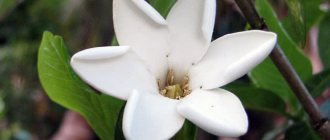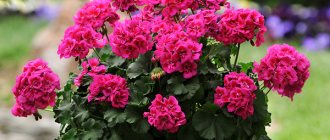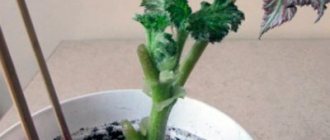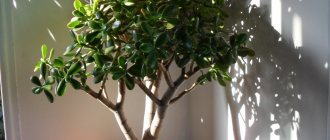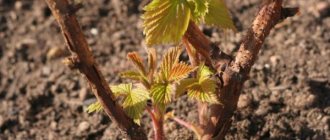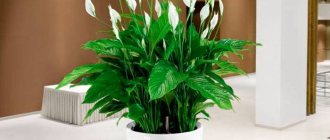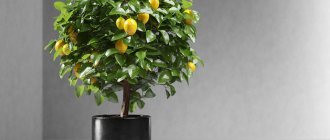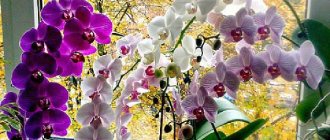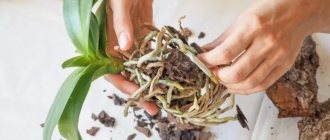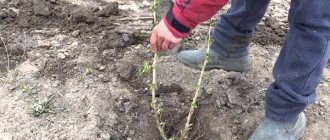- Further care
Begonia has been grown at home for hundreds of years. This rather attractive flower crop has become widespread recently. The flower is considered a suitable plant for those who are just taking their first steps in floriculture. Although the culture is unpretentious, there are still some nuances to keeping it in an apartment.
Here we will talk about how to care for begonias in a pot at home for beginners.
First you need to find out what varieties of begonia exist that are suitable for indoor growing. Then you need to figure out what conditions need to be created. This applies to soil, temperature, lighting, humidity, as well as other conditions for successful development.
Types of begonias for home breeding
All varieties of these flowers are divided into three main groups.
Decorative flowering begonias. Plants with beautiful flowers of red, pink, and white colors are included in this category. They can bloom all year round. The most popular is the ever-flowering crop. Varieties:
- Elatior;
- Ambassador;
- Baby Win and others.
Decorative deciduous begonias. The plants do not have a common stem, nor do they have beautiful flowers. But they are distinguished by spectacular leaves of various shapes and shades. There are even patterned and edged leaf plates. The most common varieties:
- Royal;
- Tiger;
- Metallica and others.
Begonia
Tuberous begonia. Of course, it is more suitable for garden landscaping. After all, during the winter she “falls asleep” and retires. Despite this, many flower lovers grow it as an indoor plant. It is distinguished by lush, double flowers similar to peonies or roses (diameter 5-15 cm). Their colors range from snowy white to dark red tones. There are also two-color specimens.
Types and varieties
There is no single established classification of begonias today, but in the specialized literature one can find conditional options for dividing begonia species, for example, into decorative-deciduous and decorative-flowering or, for example, division according to the characteristics of the underground part - into rhizomatous, tuberous begonias and begonias with superficial root system. Some prefer to divide the species of this plant into the following groups: decorative deciduous, bushy and tuberous.
But recently, begonia species are more often divided into:
- bushy begonias with bamboo-like erect shoots;
- begonias with thin and flexible drooping or creeping shoots;
- species with thick rhizomatous lodging or lying shoots;
- species that are the ancestors of beautiful flowering hybrids.
In indoor floriculture, it is more convenient to use the following classification of begonias:
- decorative flowering indoor begonias;
- decorative deciduous indoor begonias;
- decorative flowering potted begonias.
We offer you the names of the types of begonias most common in indoor culture, with their brief descriptions, as well as the names of the varieties of begonias belonging to these species. Deciduous begonia, or leaf begonia, in indoor floriculture is represented by the following species:
Royal begonia (Begonia rex)
The plant is native to Eastern India. This is one of the most beautiful begonias, on the basis of which numerous decorative deciduous varieties and hybrids have been bred. It has a thickened rhizome and beautiful, large, bare or slightly pubescent leaves up to 30 cm long and up to 20 cm wide, asymmetrical heart-shaped with wavy or unevenly jagged edges of bronze-brown, velvety crimson or red-violet color, which are sometimes decorated with red-violet or silvery spots.
There are hybrids with almost black leaves with crimson spots. This species blooms with inconspicuous pink flowers.
The best varieties of royal begonia:
- Cartagena is a variety with dark green rounded leaves wrapped in a shell. The dark brown center of the leaf becomes plum-colored as the plant matures. The green background of the leaf is covered with silvery spots with a pinkish glow;
- Silver Greenheart is a plant with silvery, obliquely heart-shaped leaves with an emerald green border splashed with silver;
- Chocolate Cream - the middle of the spirally twisted sheet of this variety has a juicy plum shade, and the main part of the plate is silver with a pink tint;
- Evening Glow is a variety with medium-sized leaves with a bright crimson center, from which greenish-brown veins radiate across the crimson field. The edge of the leaf blade is crimson;
- Hallelujah is a variety with large, spirally twisted leaves at the petioles, soft purple leaves with a silver tint. The center and edge of the leaf blade are cherry-colored, and between them there is a wide bright green stripe, completely covered with silvery spots.
In addition to those described, the following varieties and hybrids of royal begonia are popular: Lilian, Pearl de Paris, Red Tengo, Regal Minuet, Titica, Silver Corkscrew, Benitochiba, Black Fang, Deudrop, November Frost, Charm and many others;
Tiger begonia (Begonia bowerae)
Or Bauer's begonia, or maple-leaved begonia, is native to Mexico. This is a low plant - it reaches no more than 25 cm - with a creeping stem and light green leaves with black or brown spots along the edges. The underside of the leaf blade is pubescent. Light pink, inconspicuous flowers are collected in drooping, loose inflorescences. This species is rare in nature, but thanks to hybridization carried out by breeders, many very spectacular varieties have been developed.
- indoor azalea
The best varieties of tiger begonia:
- Tiger is a plant with a creeping stem, reaching a height of 10 cm. The leaves are velvety, bronze with a pattern, along the veins there is a brown stripe, the petioles are reddish, spotted;
- Cleopatra - this variety has leaves covered with light hairs that change color depending on the lighting, the underside of the leaf blade is red or burgundy.
Coral begonia (Begonia corallina)
A semi-shrub plant from the tropical forests of Brazil, in indoor conditions reaching a height of about 1 m. The stems of this species are erect, bare, resembling bamboo. The leaves have serrated edges, oblong, ovate, up to 20 cm long and up to 7 cm wide. The upper side of the leaf blade is dark green with silver spots, the lower side is light green. Flowers on coral peduncles are collected in racemes.
The most famous varieties:
- Alfalfa is a plant with large green leaves with jagged edges, covered with silvery spots on the upper side of the leaf. The underside is red;
- President Carnot is a variety with shield-shaped leaves dissected at the base of the plate with a slightly toothed edge. Leaves are up to 30 cm long, up to 15 cm wide, with whitish spots on the green background of the leaves.
Caroline begonia (Begonia carolineifolia)
One of the oldest indoor plants, imported from Mexico. It has a creeping stem about 4 cm thick and large, palmately dissected leaves up to 35 cm long, with obvious venation, located on yellow-green petioles. The flowers are greenish-pink, collected in loose racemes, open in February.
In addition to those described, the following types of decorative deciduous begonias are in demand in culture: Mason, striped, hogweed, metallic, white-spotted, Bovera, red-leaved, yellow, Limminga, brilliant, imperial and many others.
Decorative flowering species of begonia in indoor culture are:
Begonia semperflorens
A small bush-like plant reaching a height of 60 cm with erect shoots when young, and in an adult plant they take an ampelous or semi-ampeloid shape. The leaves of begonias of this species are round, slightly pubescent along the edges, up to 6 cm long, light green, dark green, sometimes with a reddish tint. Simple or double flowers of white, pink or red, up to 2.5 cm in diameter, are collected in short-lived inflorescences that quickly fade, but are immediately replaced by other flowers.
If you provide good care for your ever-flowering begonia and provide it with the necessary lighting and nutrition, it can bloom in winter.
The best varieties of this species are:
- Gustav Knaake - a spreading bush up to 30 cm high with green leaves with a red outline and bright carmine flowers up to 3 cm in diameter, collected in inflorescences;
- Carmen is a medium-sized begonia with brown leaves with anthocyanin and numerous pink flowers;
- Ambergris is a plant up to 15 cm high with brown leaves and pink flowers up to 3 cm in diameter;
- Bikola is a bush up to 14 cm high with green leaves and white flowers with pinkish edges;
- Orania is a compact bush up to 16 cm high with green leaves with a red edge and orange-red flowers.
Varieties of ever-flowering begonia Leila, Bella, Lucifer, Rozanova, Scarletta, Linda, Albert Martin, Ball Red, Othello, Kate Teicher and others are also grown in cultivation.
Begonia x elatior
This is the brightest and most abundantly flowering hybrid plant, an absolute favorite among indoor begonias. It reaches a height of no more than 40 cm, it has a fleshy thick stem and alternate heart-shaped leaves up to 8 cm long with a jagged edge. The upper side of the leaves is glossy, bright green, the lower side is matte and lighter. Flowers are collected in inflorescences on long peduncles.
The most famous varieties:
- Schwabenland is a tall variety that blooms profusely with small bright red flowers;
- Renaissance - double begonia, tall, red flowers with ruffled petals;
- Louise is a variety with light cream flowers with a pinkish tint:
- Piccora is a low-growing begonia with double flowers of a bright pink hue;
- Rose is a variety with dark pink double flowers.
Also popular are the varieties of begonia elatior Sharlach, Kyoto, Cleo, Goldfinger, Annebelle, Azotus, Bellona, Berlin and others;
Begonia x tuberhybrida pendula
It is often grown in gardens and for decorating terraces and balconies. It is characterized by drooping shoots descending in cascades with numerous flowers. Ampelous begonias are grown in hanging flowerpots, baskets and pots. Among this group of begonias there are varieties with simple, semi-double, double and densely double flowers in white, red, pink, yellow and orange, as well as all sorts of combinations thereof. Flowers can be small, medium-sized or large.
We offer you several of the best varieties of hanging begonia:
- Gale is a spreading bush with long hanging shoots up to 30 cm long with jagged green leaves pointed at the top and semi-double pale pink flowers up to 3 cm in diameter;
- Christie is a spreading bush with weak hanging shoots up to 40 cm long and white double flowers up to 4 cm in diameter;
- Roxana is a compact bush with hanging shoots up to 40 cm long with orange double flowers up to 4 cm in diameter;
- Kati is a spreading bush with weak shoots up to 30 cm long with semi-double yellow flowers up to 3.5 cm in diameter.
Among decorative flowering begonias, the following hybrid varieties are popular today:
- Harlequin is a large-flowered variety with a spreading bush up to 25 cm high with green leaves and double flowers up to 12 cm in diameter, yellow with a red border;
- Gold Dress is a semi-spreading variety up to 25 cm high with light green leaves and pink, dense yellow flowers up to 20 cm in diameter;
- Duck Red is a semi-spreading bush no more than 16 cm high with bright green foliage and dark red double peony-shaped flowers up to 10 cm in diameter with wide petals;
- Camellia Flora is a compact bush up to 25 cm high with green leaves and pink camellia-shaped flowers up to 12 cm in diameter with tiled petals with a white border;
- Crispa Marginata - a bush up to 15 cm high with green folded leaves with thin purple ropes and white flowers up to 12 cm in diameter, wide oval in shape with a bright pink border and strongly corrugated wavy side petals;
- Ami Jean Bard - a bush up to 12 cm high with small green leaves and inflorescences of 5 double orange flowers up to 3 cm in diameter;
- Diana Vinyard is a compact begonia up to 20 cm high with light green foliage and densely double white flowers up to 20 cm in diameter with folded wavy petals;
- Marmorata is a semi-spreading bush up to 20 cm high with double scarlet flowers up to 12 cm in diameter with white streaks;
- Feuerflamme is a bush up to 20 cm high with green leaves with crimson veins and semi-double flowers up to 3 cm in diameter, orange-pink.
Agrotechnics of cultivation
Chrysanthemum in a pot (care at home)
Choose light-colored window sills for placing begonias. However, it is necessary to protect plants from direct sunlight, especially during the flowering period. Otherwise, the leaves may get burned. Bushes should be shaded using blinds or newspapers.
Note! Deciduous varieties require indirect light.
Required daylight hours for plants (12-14 hours). In the autumn-winter period, it is necessary to provide begonias with additional lighting using phytolamps or daylight devices.
In spring and summer, the comfortable temperature is +20-22 degrees. In autumn and winter, the temperature should be +15-19 degrees. Sharp fluctuations in temperature, as well as its drop below +14 degrees, can lead to leaf fall or even death of the plant.
Comfortable conditions are very important for begonias
It is necessary to provide begonias with high humidity. It should be at least 60-80%. Pour expanded clay or gravel into a wide tray and moisten it. Place a pot with a plant on it. They also install containers filled with water, fountains, and aquariums next to the bush.
Important! Do not spray begonias. Drops of water cause brown spots to form on the leaves.
The plant loves light, fertile, loose, breathable, slightly acidic soils (acidity pH 5.5). You can buy ready-made soil in the store or prepare it yourself. Its composition:
- leaf soil (2 parts);
- peat (2 parts);
- compost (1 part);
- sand (1 part).
To make the soil more loose, add vermiculite, perlite, and coke fiber. Dolomite powder, lime, and wood ash are used to reduce acidity. Sift the prepared mixture and remove large fragments. Scald the soil with boiling water or bake it in the oven.
Care
After the plant is transplanted, you will need to follow a few simple rules:
- after abundant watering during replanting, you must wait until the top layer of soil has completely dried (about 5 days) and only then return to the normal watering regime;
- until the plant takes root, it should be placed in the shade;
- exclude heat, cold and drafts.
In the future, you can resume standard care for begonia.
- Lighting . For abundant flowering, begonia needs diffused light (how to achieve beautiful buds?). It is best to place it on the windowsill of a western or eastern window, and provide additional light in winter.
- Watering . In summer, the flower must be watered twice a week, in extreme heat - daily. From about October, begonia needs to be watered only if the top layer of soil has dried out, and in winter - only once every few weeks. Watering is done with settled soft water, the excess of which must be drained from the pan.
- Humidity . You should not spray the flower - this may cause spotting on the leaves. You can increase the humidity by placing a flowerpot on a saucer with wet peat or placing pebbles in a tray of water and placing a flower on top.
- Temperature.
Comfortable temperature for begonia in summer is 18-20 degrees, in winter - not lower than 15 degrees.The flower does not tolerate temperature changes well.
- Fertilizers . Nutrient compositions prolong flowering and serve as excellent prevention of pests and diseases. You can buy fertilizer at a flower shop. The composition must be intended for indoor crops and contain magnesium, potassium, calcium, phosphorus, and iron. The dosage should be 2 times lower than indicated in the instructions. In winter there is no need to feed begonia, at other times - twice a week. You cannot use fertilizer containing chlorine.
Transplanting begonias is an important and responsible process ; health, growth, flowering and color development in the future depend on it. That is why it is important to carefully prepare for this procedure, choose the time and select the appropriate flowerpot and soil. All these efforts will not go unnoticed - in return, the begonia will decorate everything around with its incredibly beautiful and long-lasting flowering.
What kind of pot is needed for begonias
Breeding chickens at home for beginners
Choose a small container for the small petiole of the plant. Begonia pot size is 5 - 6 cm. It must have drainage holes. After about 6 months, when the young seedling has grown its root mass, it is transplanted into a larger container (8 - 10 cm).
Begonia in a suitable pot
Subsequent replanting depends on the formation of roots. For example, they carry it out after a year. Take a container one third larger than the previous pot. If you immediately plant the plant in a large pot, the roots may rot.
It is preferable to use round pots for begonias. Ceramic flowerpots are considered the best. They do not retain moisture and air circulates well. Although regular plastic containers will also work.
Transplant technology
Transplanting begonias at home is a simple matter, the main thing is to do everything correctly. So, how to transplant begonia correctly? First of all, you need to choose a suitable pot. It should be slightly larger than the one in which the plant was previously contained, but not be free - this negatively affects the root system. Next, you should choose a suitable soil mixture so that your beauty feels great in her new place.
A mixture of peat, humus, turf and ordinary soil, taken in equal proportions, is ideal. In addition, it is worth taking care of the plant that will be transplanted and providing the new location with good drainage. For this, various materials are used: expanded clay, tiles, crushed stone or even polystyrene foam, cut into cubes. Now, once all the preparations have been completed, it's time to learn how to replant begonia at home.
It is worth remembering that the procedure will be much easier if you moisten the soil in a new pot a few days before it.
Next, you need to very carefully remove the flower from the pot. To make the procedure easier, you can knock on its walls so that the earthen lump moves away from them a little and makes it easier to get it out. Shake the clod from the ground and inspect the roots: rotten or dried ones must be cut off - there will be no benefit from them, but harm is quite possible. After the unwanted elements have been removed, treat the cut areas by sprinkling them with cinnamon or crushed activated carbon.
Now you can slowly place the extracted plant in the center of the new pot. The soil should be added very carefully, making sure that neither the roots nor the leaves of the flower are accidentally broken. Don’t be afraid to compact the soil - feel free to press it down with your fingers and add a new layer when it settles. There should be no more than 1 cm left to the top edge so that you can easily water your beauty and the water does not spill over the edges. The last thing that needs to be done before the procedure can be considered complete is to water the flower generously. Do not spare water - there should be enough of it so that it begins to come out of the drainage hole. This way you will moisten the soil well, but in the future you won’t need as much water - this is a one-time procedure.
This is interesting: What to do if ficus leaves turn yellow and fall off: we eliminate the problems
How to plant a flower?
Methods for planting begonias depend on its type:
- By cuttings - suitable for plants that have a stem.
- Leaf parts - good for varieties with pubescent leaves and for creeping species.
- Seeds - for flowering varieties.
- By dividing the rhizome - for begonias growing in bushes.
- By dividing the tuber - for species with a tuberous root system.
Let's take a closer look:
- For propagation by cuttings you need to cut off the apical or middle part of the stem with two or three nodes 7-10 cm long with a sharp knife. Treat the cut with activated carbon or cinnamon and dry for 1.5-2 hours. There are 2 options for rooting:
- Place the cuttings in warm water in a well-lit place. After the roots appear, plant them in a pot.
Treat the cut of the stem with a root formation stimulator and place it in the prepared soil to a depth of 1-2 cm. Cover the container with glass or polyethylene and ventilate periodically.
- To propagate by leaf parts, you will need a strong, healthy leaf, which is cut so that each piece contains part of the central vein. Place the resulting pieces on the surface of damp soil and lightly press down. Or simply make cuts on the whole leaf across the main leaf veins and lay it on the soil surface face up. Similar to the previous method, cover with film until rooting.
- Growing new plants from seeds is the most labor-intensive and time-consuming task. Sowing is recommended to be done in January. Begonia seeds are sprinkled on top of the sifted, moistened soil and covered with glass. Moisten only with a spray bottle, avoiding the soil from drying out. While waiting for germination, namely 1-1.5 weeks, the greenhouse is kept in a sunny, warm place, briefly ventilated. As it grows, a 2*2 pick is made, creating space for development. Ventilation is required more often and longer. Next, they make another 4*4 pick or immediately transplant it into a new container without the film.
- Method of dividing rhizomes apply in early spring. The order of steps is as follows:
- Remove the flower from the pot. To do this, turn the flowerpot upside down, holding the flower with one hand and tapping the bottom with the other.
- Inspect the bush and remove dry, yellowed and overly large leaves, flower stalks and overgrown stems.
- Remove the soil from the roots and remove dried and rotten parts.
- Rinse the rhizome in water and let dry a little.
- Using a sharp knife, divide the plant so that each part contains a root and a bud or shoot.
- Treat the cut areas with activated carbon.
- Treat the plant with a root growth stimulator.
- Prepare a pot with drainage holes. If it has been previously used, disinfect it. The diameter and height of new pots should be 2-3 cm smaller than the pot in which the bush grew.
- Cover 1/3 of the height of the container with expanded clay, pebbles, fragments of ceramics or other materials suitable for drainage.
- Place charcoal 0.5-1 cm thick on top of the drainage layer.
- Add a small layer of prepared soil and install the plant.
- Fill in the remaining substrate, leaving 1-1.5 cm unfilled to the edge of the pot. Do not compact the soil - it should remain loose and light.
- Pour plenty of warm water until water begins to seep into the pan. Drain the water from the pan.
Rooting takes 2 to 4 weeks. Once new leaves appear, there is no need to cover with film.
The nuances of replanting tuberous species
For begonias with a tuberous root system, this method is the most effective. A plant aged 2-3 years with an undamaged tuber on which 2 to 5 buds have formed is suitable.
It is better not to use tubers with shoots that have already appeared.
- Cut the tuber into pieces with a sharp knife so that each of them has at least one bud.
- Treat the cut areas with activated carbon or ash.
- In a container with moist soil, half-deep the tuber pieces with the buds facing up and cover with film.
- The greenhouse is placed in a well-lit place at a temperature of 18-20ºC. During the germination stage, water through a tray.
- After rooting, remove the greenhouse, and when the sprout reaches a height of 6-8 cm, cover the tuber completely with soil.
Is it possible to disturb a flowering plant?
It is recommended to replant the plants into a new container immediately after purchase, since when selling, light soil and plastic pots are used - not the best option. But what to do if you purchased a flowering plant? Knowing what species begonia belongs to, the issue can be resolved.
For example, beautifully flowering and evergreen begonias will not be harmed and the flowers will not be dropped if handled carefully. Tuberous begonia, on the contrary, is very capricious during flowering. This is the case when transplantation is fraught with the cessation of flowering not only immediately after transplantation, but also in the future.
If you are not sure what species the plant belongs to, or you know for sure that the flower has a tuberous root system, then it is better to wait until the begonia has bloomed and then transship it.
How to choose begonia for planting in a pot
How to feed rabbits at home for beginners
When purchasing a plant, you must carefully inspect it. The leaves must be elastic and free from stains, damage, and insect pests. It is best for the buds on the bush to be half-open. This way, when the environment changes, the plant will quickly get used to the house.
If you want to buy begonia tubers, they must be strong, dense, not overdried (diameter at least 4 cm), and without mold. Typically, a high-quality onion has a convex bottom, a concave or flat top, as well as tubercles and irregularities (growth points) located in the upper part.
Begonia tubers
It is best to purchase tubers at the end of February - March. At this time, reddish or white buds will be visible on healthy bulbs. And in January - February it is difficult to determine them. They are still hibernating.
In what cases is a transplant required?
Begonia roots develop quite slowly, which is why the flower does not need to be replanted too often . A healthy plant that has not fully developed the soil should not be replanted.
However, there are a number of cases when a transplant is necessary:
the pot became too small for the root system and roots began to peek out from the drainage holes;
- the plant is sick, which is expressed in yellowing of the leaves or its general inhibition (read about why begonia leaves curl and what needs to be done here);
- pests have infested the soil;
- the previous pot is damaged.
If the begonia is small in size, then the need for replanting is determined as follows: it is necessary, holding the plant with your hand, turn it over together with the flowerpot and pull the flowerpot up with the other hand. If the roots entwine the entire earthen ball, a transplant is needed .
In addition, it should be remembered that the need to change the soil is also due to the fact that it is depleted with prolonged use, which creates negative conditions for growing begonias.
How to plant begonia
All types of begonias are best planted in the spring. You can pre-treat the roots of the plant with a fungicide.
Expanded clay or coarse sand is poured into the bottom of the pot. Place charcoal on top of it (layer 2-3 cm). This is necessary to avoid root rotting. Then the prepared soil is filled in.
Note! The container should be 4 centimeters larger than the root system.
Planting begonias
Plant the plant in the center of the pot, sprinkle it with soil (leave 1 cm to the edge), do not compact it. Water generously and drain excess water from the saucer. If the soil settles, add more soil.
Important! The growing point should remain above the ground.
Planting with a tuber
The best time is March. The tubers are pre-germinated. They are planted in a mixture of leaf soil with peat or purchased soil. There should be drainage at the bottom of the container.
Place the containers in a bright place. Maintain high humidity and the desired temperature (+18 degrees). Water into a tray.
Planting begonia with a tuber
When sprouts appear, transplant the onions into pots. Do not fill them with earth to the brim. After the nodules grow, sprinkle with soil (3 cm thick).
When is the best time to replant?
It is best to transplant begonias into a new container two or three weeks after purchase. Typically, such crops are sold in small flowerpots, so this procedure involves moving the flower to a larger container. In general, replanting is carried out as needed, when the root system of the plant does not fit into the old pot or the begonia does not have enough nutrients in the old soil.
It is best to carry out such procedures in early spring, when the crop begins to emerge from its dormant state. A drainage made of expanded clay or other material and a little sifted river sand is placed at the bottom of the container. The plant is carefully pulled out of the old pot, its roots are cleaned of peat residues and placed in a disinfectant solution of potassium permanganate of 1% concentration. Areas with damaged root systems are removed.
When replanting, try not to add enough nutrient mixture to the top of the pot. When the soil settles, you can add more. After the procedure, the plant needs to be watered well and access to sunlight limited. The transplanted culture is temporarily installed in the back of the room away from the windowsill. After 3-4 weeks, the flower can be transferred to the windowsill.
How to care for begonia in a pot at home after purchase
- First of all, you need to choose the right place for the plant. If you buy begonia in the fall, in winter you place it on the windowsills of eastern or western windows.
- The plant, purchased in the spring-summer period, is placed on the windowsill of the northern window. You cannot move a flower from one place to another; it must be protected from drafts. It should also be taken into account that begonia loves space, which means it is better not to place it next to other plants.
- There is no need to water the begonia for the first 5 days after you bought it. She must get used to the new home.
- You should not replant the plant immediately after purchase, especially in the flowering phase. It is necessary to replant if the plant is flooded or the condition of the soil in the pot does not inspire confidence.
- The plant needs quarantine for 2 weeks. Then they assign it to a permanent place.
Further care
From spring to autumn, begonia is watered abundantly (1 time / 3 days). Moisten when the soil dries to a depth of 1.5 cm. In the heat of summer, watering can be more frequent, almost daily. Complex fertilizers are added to the water every 10 days. For irrigation, use settled water at room temperature.
Watering begonias
In autumn and winter, reduce irrigation (1-2 times/7 days). How to water begonia in a tray or pot. This question is asked by many beginning flower growers. Irrigate root begonia at the root. It is unacceptable for water to get on leaves and flowers. If the plants are tuberous, pour water into a saucer.
Note! Begonias do not tolerate excessively wet or dry soil.
Top dressing
During budding and flowering, flowering begonias are fed with potassium-phosphorus substances (2 times/month). Nitrogen compounds should not be used. Plants may lose all their buds or not bloom at all.
But decorative deciduous varieties require nitrogen substances.
Trimming
Young plants are pruned for the first time when the stems are 6-7 centimeters long. After such an operation, watering is reduced until new shoots form.
Begonia pruning
After the side stems grow 10 cm, cut off their tops above the outer buds. Subsequently, the elongated branches are removed and a beautiful crown is formed.
Transfer
The plants are replanted when the roots become cramped in the pot (frequency: once/1-2 years). The procedure is carried out in the spring. Carefully remove the bush and water it first. Remove soil and damaged fragments.
Immerse the horse system in a weak solution of potassium permanganate for 30 minutes. Then they are washed in running water and dried. Place drainage in the new pot. Place the plant in a pot larger than the previous pot (by 3-4 cm).
Typical mistakes during transplantation
Violating the requirements for replanting a plant can cause the death of flowers, so you need to know what not to do during this event. The most important mistakes are:
- Incorrect container size selected. In a pot that is too large, the plant grows very slowly and may not bloom.
- The soil is too dense. So the plant does not receive nutrients due to the fact that oxygen access is blocked. Water will not be completely removed, and the acidity of the soil will increase, which will negatively affect the plant.
- Large depth of the root collar. With such an error, the begonia may die.
To enjoy the beautiful flowering of begonia, you need to properly care for it and plant the plant. The main thing is to follow the technology of performing the work and not to touch flowering plants. If the soil is loose and nutritious, and watering and fertilizing are carried out in a timely manner, begonia will reward you with lush and long flowering.
How to care in winter
With the onset of autumn, caring for tuber crops ends. Dig up the bulbs after all the tops die. Dry them and place them in peat or sand. The tubers are checked occasionally (1-2 times/month). Store in a cool place (basement, glassed-in balcony) until spring.
Digging up tubers
Plants with decorative leaves need the same care as in summer. True, they reduce watering, lower the temperature (+16 - 18 degrees), and arrange additional lighting. It is not advisable to leave flowers near the heating system.
As you know, Elatior begonia can bloom all year round. However, experienced flower growers recommend giving them a rest. You just need to pinch the tops of the shoots. They need the same winter care as decorative deciduous species.
How to plant a plant?
With the onset of spring, begonias that grow as bushes need to be planted . To do this you need:
- Remove the plant from the pot.
- Remove overgrown stems, peduncles and large castings. Carefully wash the root system from the soil with water.
- Using a sharp knife, break the bush with roots into pieces so that each individual plant has a bud or sprout.
- Sprinkle the cut area with activated carbon.
- Treat the roots with Kornevid, plant the plants in pots and water.
Diseases, pests
- Powdery mildew, gray rot. Treat with fungicides, reduce the humidity in the room, ventilate it, and reduce watering of the plant.
- Aphid. Spray with soap solution, use tobacco infusion, chemicals.
- Spider mite. Wash the bushes with soapy water and apply insecticides.
- Root-knot nematode. Destroy affected plants.
With proper care, the plant will delight you with abundant flowering and a pleasant aroma almost all year round.
0 0 vote
Article rating
Possible problems
Diseases
- Vascular bacteriosis - begonia leaves begin to dry at the edges. The same symptoms can be observed if the watering regime is not followed.
- Dropping of leaves and buds - this problem may be a consequence of too dry air or an overdried earthen clod.
- Powdery mildew - appears as a white coating on the leaves of begonia. The development of the disease is stimulated by a combination of high temperature and dry indoor air.
- Gray rot - looks like gray spots on the leaves. Occurs from excessive watering.
- Curled leaves are a symptom with which begonia reacts to lack of moisture and dry air.
- The pallor of the leaf blades is observed in the plant in case of lack of light.
- Buds and flowers darken and fall off if direct contact with water was allowed, or if excessive watering was carried out.
We invite you to watch a video about begonia diseases:
Pests
- Scale insect - reveals its presence by the fact that the leaves become shiny and sticky.
- Spider mite - with its appearance on the back of begonia leaves, you can see a thin cobweb, the leaves turn yellow and dry out. Lack of nutrients contributes to the appearance of the pest.
We invite you to watch a video about begonia pests and how to combat them:

